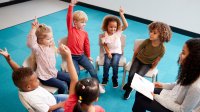3 SEL Practices That Early Childhood Educators Can Use Every Day
These simple social and emotional learning activities can make a big difference for the youngest students.
Your content has been saved!
Go to My Saved Content.Providing our young learners with a strong foundation can set them up for success for many years to come. Relationship skills, social awareness, and self-management are essential social and emotional learning (SEL) tools to add to our learners’ tool kit to help them navigate all their new experiences in life and in learning.
Below are three SEL signature practices from the Collaborative for Academic, Social, and Emotional Learning. Within each of these practices, we share methods specifically designed for early childhood. Consider your scenario as well as the needs and size of your group when deciding which activities are most appropriate for your learning community.
1. Welcoming Inclusion Activity
We often hear the phrase “Maslow before Bloom,” which means we must be mindful that in order for learners to truly be creative and solve problems, they must feel safe and valued. With that in mind, how we enter into the learning environment is an opportunity to establish the mood and tone as well as create a sense of belonging.
Morning check-ins: There are a variety of ways that learners can enter our classrooms, and we know that they are coming with different experiences before they enter the space. Consider using an attendance routine with a photo of learners’ faces (or an avatar) where learners can independently check themselves in and know they are part of the environment (self-management, social awareness).
Class meetings: Class meetings are a powerful way to build and maintain community (social awareness, relationship skills). Gathering learners in a circle, we can explicitly talk about emotions and ways to regulate (“Name it to tame it”). Using a tool like the mood meter during circle time, we can develop self-awareness and self-management learning from each other.
Singing: When we see learners in the kitchen area pretending to be one of their family members, phone in hand chatting about making dinner, they’re learning through mimicking what they see around them. The call-and-response nature of songs helps gift learners with new language through copying what they see their peers and teachers doing, learning through shared experience (social awareness).
2. Engaging Strategies
One of the many joys of teaching preschool and early-elementary children is the signals our little ones give us when it’s time to shift gears. Those who teach older kids may wonder when they do or don’t have their learners’ full attention, but we know. It might start with mouth bubbles, extra fidgeting, a rise in the noise level, or all of the above, but we sense the energy shifting and adjust accordingly. In fact, we are constantly anticipating and responding and, when necessary, restoring.
Anticipating: We know that it’s unreasonable to ask very young learners to sit for extended periods of time, so we are careful to plan accordingly. Play-based exploration is a great way that we can set up provocations to scaffold learning experiences and then follow how the learners respond to the activity.
Social stories and role-play allow learners to explore different scenarios using their prior knowledge and imagination for learner-guided experiences as well as teacher-guided opportunities, modeling vocabulary and transfer of new ideas (relationship skills).
Visit the Center on the Social and Emotional Foundations for Early Learning for even more ways to integrate literature and SEL.
Responding: We can’t always anticipate when we will need to shift the energy and/or break up the time, so it’s a good idea to have brain breaks ready to go. For example, bookmark some of your favorite GoNoodle videos for energizing. When you need to calm the room, try palming (self-management).
Restoring: Even with all the anticipating and responding, sometimes things escalate and require more than simple coaching and redirection. Restorative practice circles provide kids (and adults) a safe space to practice listening, speaking, and taking responsibility for our actions. We can start with a breathing practice to reset and then move into a discussion giving students an opportunity to express their perspective and emotions (self-management, self-awareness, social awareness, relationship skills, responsible decision-making).
3. Optimistic Closure
We can build confidence and promote communication skills in our youngest learners when we collectively and individually celebrate what we have accomplished.
Examples:
- Do a “One-Word Whip Around” responding to a prompt like “Share one word that describes how you feel about your learning for today” (self-awareness, self-management).
- Ask kids to finish this sentence, “I am curious about…” or “I want to learn more about…” (responsible decision-making, self-awareness, social awareness).
- Practicing gratitude has been proven to improve relationships, well-being, and academic performance. Ask students to name someone or something that brought them joy today (self-awareness, social awareness, relationship skills).
Involving Families as Partners
The more we bring families in as partners, the more effective we are in nurturing the whole child. Using learning journals/portfolios and communication tools allows families to fully appreciate the hard work and accomplishments of their child. We even have digital tools such as Seesaw and Flipgrid that give families a window into the classroom. This is especially helpful for those who don’t drop off or pick up their child.
Using developmentally appropriate practices as part of a systemic SEL approach allows us to help our littlest learners develop the social and emotional skills that will serve their academic success and help them thrive throughout their lives.
